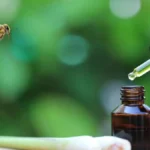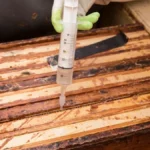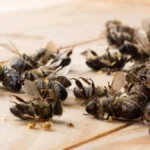Does lemongrass attract bees? The short answer is yes. The long and fun answer is the rest of this article. Lemongrass is an amazing grass herb that contains terpenes that attract bees. Let’s see how we can use this to our advantage.
What Is Lemongrass?
Lemongrass species are all part of the genus Cymbopogon. The most commonly cultivated is West Indian Lemongrass – Cymbopogon citratus. This plant and a few similar species produce a series of essential oils that are rich in terpenes. These terpenes confer a strong lemon scent to the oil.
What Are Terpenes?
Terpenes are hydrocarbons. They consist of various numbers of repeats of (C5H8)n. Â
Terpenes are a massive group of chemicals that confer many of the medicinal and aroma properties to the herbs and flowers that we enjoy. Many of these compounds are biologically active – they can reduce inflammation, mimic hormones, and mimic pheromones.
What Are Pheromones In Honeybees?
Pheromones are chemicals that leave the body of the creature that produces them and act on the bodies of other creatures of the same species in a way similar to that of a hormone. In the honeybee hive, pheromones are one of the more important ways bees communicate and maintain their society. Queen pheromone stops workers from developing ovaries. Alarm or anger pheromone helps bees defend the hive. The secretions of the Nasanov gland are used among other functions, to help the bees orientate on a target, such as a new nest site.
What Does The Nasanov Gland Produce?
The Nasanov gland pheromonal mix is comprised of geraniol, nerolic acid, geranic acid, E-citral, Z-citral, E-E-farnesol & nerol. When bees find a nesting site, and as a swarm flies to that site, the guides in the swarm use their Nasanov glands to direct the remainder of the swarm in this direction.
I have had the good fortune of spending some time in swarms. It is a magic experience jogging along inside a swarm with bees bobbing all around you as they follow the group of bees at the lead of the swarm who know where they are going. They do this for a mile or so, and then suddenly draw together, and lift higher off the ground and then just accelerate away to wherever they were going. Remarkable. And that lemony sweet scent in the air as you run with them is the most magical beautiful perfume.
What Terpenes Are In Lemongrass Oil?
The main constituents of lemongrass oil are myrcene, limonene, citral, geraniol, citronellol, geranyl acetate, neral, and nerol. Let us place the list of hydrocarbons in Lemon Grass and Nasanov gland secretion over each other and compare.
Lemongrass: myrcene, limonene, citral, geraniol, citronellol, geranyl acetate, neral, and nerol.
Nasanov : geraniol, nerolic acid, geranic acid, (E)-citral, (Z)-citral, (E-E)-farnesol, and nerol
You can see that geraniol is common. Citronello and (E) and (Z)-citral are similar in scent. Nerol is common. Geranic acid and geraniol are very similar.
In this regard, we can see that if Lemongrass and Nasanov Secretions are words, it is the same as writing Stop or Sotp on a sign. People get the message.

Bees seem to be able to translate the lemongrass scent and are attracted to it. You can test this by mixing a bit of lemongrass bait as per the recipe detailed later in this article. If you put a little bit of it in a bottle cap and place it outside in the sun, you will find that bees will start investigating it in no time at all. Bees have an incredible sense of smell and can smell certain chemicals from hundreds of yards away if they are downwind.
How Do We Use Lemongrass Oil To Attract Bees?
At times of the year when there are a lot of swarms around, such as in spring, you can place beehive boxes that have been baited with lemongrass oil bee lures. I like to bait catch boxes with a bit of beeswax and propolis and then if you so wish you can place a good few drops of lemongrass oil just on the inside of the entrance of the hive. The lemongrass scent will linger for about a week in this method.

Alternatively, you can make some longer-lasting lemongrass bee lures using this method. Use a small double boiler to melt your beeswax. Here is an article I wrote on melting beeswax. (never use a microwave to melt beeswax)
Once your wax is melted pour in a little vegetable oil (I use coconut oil as this does not go rancid and start stinking after a while). For every cup of mixture add a teaspoon of lemongrass oil. This is strong!! Mix the whole lot with a spatula and it will become a substance a bit like Dubin as it cools. When it cools you can then place the product in cooldrink bottle lids.
Place two of these on either side of the entrance of your catch boxes and they will diffuse lemongrass scent for up to two months covering an entire spring and early summer swarming run. You can use an old empty hive to great effect to catch a swarm.
There are many tricks to placing a beehive or bait hive to catch swarms and you can read more about them here. Placing your bait hive in a spot near a strong honey flow helps a lot. Bee swarms are attracted to these sorts of places.
Does lemongrass attract bees? Yes. And now you know how to use this fact to catch swarms! Go out and give it a try. There are many ways to use this method, and you can work out your own method of baiting the hives with lemongrass. Experimenting with placing the hives in ways such that the scents accumulate and do not blow too far away in the wind also is useful. If you enjoyed this please share.
Read more about Lemongrass Oil For Honey Bees
FAQs
What is Lemongrass?
- Lemongrass is a tropical herb from the Cymbopogon genus, commonly used for its essential oils that have a strong lemony scent.
Does Lemongrass Attract Bees?
- Yes, lemongrass contains certain terpenes that mimic bee pheromones, making it attractive to bees, especially during swarming season.
How Do Bees React to Lemongrass Oil?
- Bees are attracted to the scent of lemongrass oil because its components mimic the pheromones produced by the Nasanov gland, which bees use for orientation and communication.
Can I Use Lemongrass Oil to Lure Bee Swarms?
- Yes, many beekeepers use lemongrass oil as bait in swarm traps or catch boxes to attract swarming bees looking for a new home.
Why is Lemongrass Oil Similar to Bee Pheromones?
- Lemongrass oil contains compounds like geraniol and citral, which are also found in the pheromones secreted by honeybees from their Nasanov gland.
What is the Best Time of Year to Use Lemongrass Oil for Attracting Bees?
- Spring is the best time to use lemongrass oil because it’s the season when bees tend to swarm in search of new nesting sites.
How Should I Apply Lemongrass Oil to Attract Bees?
- A few drops of lemongrass oil can be placed at the entrance of a hive box or on cotton balls inside the trap. This will release the scent over time and lure bees.
Is Lemongrass Oil Harmful to Bees?
- No, lemongrass oil is not harmful to bees. In fact, it helps guide them to new nesting sites without posing any health risks.
What Other Essential Oils Attract Bees?
- In addition to lemongrass, essential oils like lavender, spearmint, and eucalyptus are also known to attract bees due to their appealing scents.
Can I Make My Own Lemongrass Bee Lure?
- Yes! You can create a simple lure by mixing melted beeswax with coconut oil and adding a few drops of lemongrass oil. Place it near hive entrances to attract swarming bees.

Dr. Garth A. Cambray is a Canadian/South African entrepreneur and beekeeper with 28 years of experience in apiculture and specializes in adding value to honey. His Ph.D. research developed a new advanced continuous fermentation method for making mead that has resulted in a number of companies globally being able to access markets for mead. His company, Makana Meadery, exports honey mead to the USA where it is available to discerning connoisseurs. He has also developed technologies to commercially manufacture organic honey vinegar in Zambia for export globally. He holds a few patents globally in the ethanol industry and believes in technology and knowledge transfer for human development and environmental sustainability. One of his proudest achievements is the fact that the wind farm he started at one of his old apiary sites has essentially made his hometown carbon neutral.






